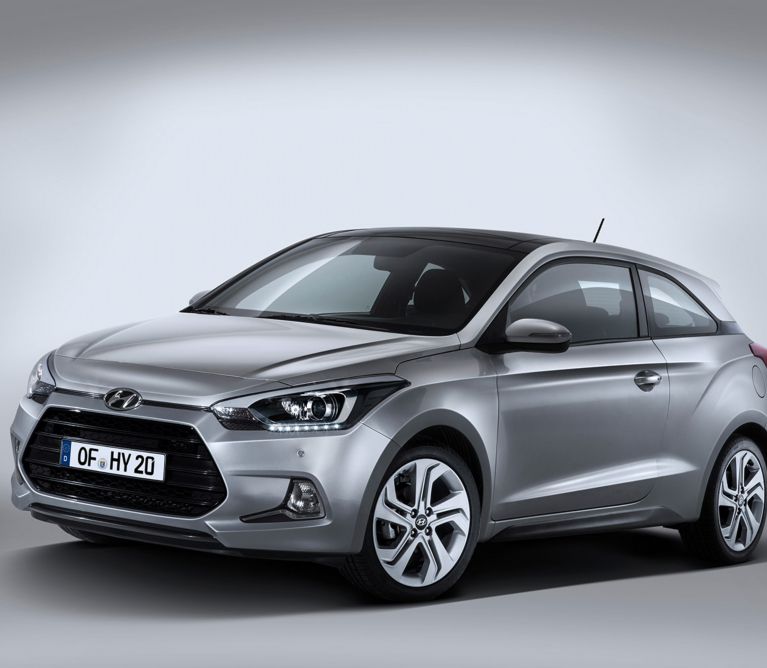- Unique silhouette of New Generation i20 Coupe with differentiated A-, B- and C-Pillar
- Reverse hexagonal emphasises dynamic character
- New rear design creates unique athletic presence
Press material
-
Download
-
Images
New Generation i20 Coupe offers a unique silhouette in the B-segment.
The A-, B-, and C-pillars differ between three- and five-door models, each is more raked providing the Coupe with its own dynamic profile thanks to a stylish sloping roofline, 25 mm lower than its five-door sibling. Interpreting the New Generation i20’s distinctive floating roofline, the Coupe utilises a slim black C-pillar application that emphasises its unique rear design even further.
New Generation i20 Coupe has been styled with a reverse hexagonal front grille, which works harmoniously with redesigned front bumpers, matching new side sill mouldings and a sporty, rear spoiler.
A muscular character line dominates the rear of New Generation i20 Coupe leading into the new rear bumper design and creating an, athletic presence.
The front of the New Generation i20 Coupe features a reverse hexagonal grille that, framed by iconic side bumper features, lowers the visual stance and emphasizes its road-hugging character. We gave the car a sleeker looking side profile and a more appearance, while retaining generous space of rear passengers. The strong feature over the rear wheels emphasizes the shoulders and directs the attention to the striking horizontal rear lights. Together they underline the sport-oriented image of the car.
The sophisticated relationship between design and functionality continues around to the rear with new tail lamps. 17-inch alloy wheels are unique to the Coupe model, enhancing its sporty character. The stylish touches continue, including unique Tangerine Orange exterior paintwork carried through to a matching fashionable orange interior trim with orange decals, found exclusively in the Coupe interior.
Consumption Data*
Gasoline Engines
1.25 MPI (75 PS): Fuel consumption combined: 5.1 - 4.7 l/100 km; urban: 6.6 - 5.8 l/100 km; extra-urban: 4.2 - 4.0 l/100 km; CO2 emissions combined: 119 - 109 g/km
1.25 MPI (84 PS): Fuel consumption combined: 5.1 - 4.7 l/100 km; urban: 6.6 - 5.8 l/100 km; extra-urban: 4.2 - 4.0 l/100 km; CO2 emissions combined: 119 - 109 g/km
1.4 MPI (100 PS): Fuel consumption combined: 6.4 - 6.2 l/100 km; urban: 8.5 - 8.2 l/100 km; extra-urban: 5.1 - 4.8 l/100 km; CO2 emissions combined: 148 - 143 g/km
1.0 T-GDi (100 PS): Fuel consumption combined: 4.6 - 4.0 l/100 km; urban: 5.8 - 5.0 l/100 km; extra-urban: 3.9 - 3.4 l/100 km; CO2 emissions combined: 107 - 94 g/km
1.0 T-GDi (120 PS): Fuel consumption combined: 5.0 - 4.6 l/100 km; urban: 6.3 - 5.8 l/100 km; extra-urban: 4.2 - 3.9 l/100 km; CO2 emissions combined: 115 - 107 g/km
Diesel Engines
1.1 CRDi (75 PS): Fuel consumption combined: 4.0 - 3.2 l/100 km; urban: 4.9 - 3.4 l/100 km; extra-urban: 3.4 - 3.0 l/100 km; CO2 emissions combined: 103 - 83 g/km
1.4 CRDi (90 PS): Fuel consumption combined: 4.1 - 3.7 l/100 km; urban: 4.9 - 4.5 l/100 km; extra-urban: 3.5 - 3.3 l/100 km; CO2 emissions combined: 106 - 97 g/km
*Depending on trim and tyre specifications.








